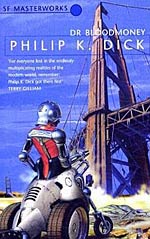
![]() Grayman14
Grayman14
11/5/2016
![]()
'And then, as he walked, he noticed that all the cross streets to the left leaned, as if the city was sinking on that side, as if gradually it was keeling over.' (p.55)
Written at the height of the Cold War, Philip K. Dick's 1965 novel Dr Bloodmoney imagines what might happen if America experienced a nuclear attack. Dick sets it in a (then) future 1981 in which there is a draft for the Cuban War, Russia's Lunar Colony has failed, and for the first time, a married couple is about to be sent on a colonization mission to Mars. As people watch the televised launch of the Mars-bound rocket, the TV screens suddenly go blank and the signal is lost...
Dr Bloodmoney is one of the most unusual PKD stories that I have read so far. It starts off ordinarily enough introducing some of the "everyman" characters that usually inhabit Dick's stories: a TV salesman, a doctor, a company owner, and so on. As they work their respective ways through an ordinary day, Hoppy Harrington enters the narrative. Hoppy is one of the most original and unforgettable characters Dick has created.
'Listen, McConchie,' Fergesson said. 'You know that kid with no arms and legs that comes by on that cart?' [...] 'His name is Hoppy. He'll be in this morning. You ought to see him move stuff with his electronic hands; it's a marvel of modern science.' (p.10)
It is not simply Hoppy's appearance that makes him stand out but the way Dick develops his personality and mannerisms, including the way he speaks. A strange atmosphere hangs over the scenes in which Hoppy appears. This is enhanced by Dick's descriptions of Hoppy's seemingly supernatural abilities. For example, early on in the narrative Hoppy goes into a trance after drinking a beer and begins to speak of the future. It's a creepy scene which I won't spoil here.
After the nuclear strike - which Dick describes minimally - the narrative flashes forward seven years. We join the surviving characters in a post-apocalyptic America of wood-burning-fuelled cars, hand-rolled cigarettes, and brief radio broadcasts from an orbiting satellite.
'Set on the side of a ridge, the Raub house overlooked West Marin County, with its vegetable fields and irrigation ditches, an occasional goat staked out, and of course the horses; standing at the living room window, Eldon Blaine saw below him, near a farmhouse, a great Percheron which no doubt pulled a plow ... pulled, too, an engineless automobile along the road to Sonoma County when it was time to pick up supplies.' (p.97)
Unlike a lot of other dystopian tales, Dr. Bloodmoney paints a picture of a future that offers some hope. Yes, there are some disturbing scenes in here, but Dick also imagines how people might live on. He offers some interesting ideas on the importance of community, on what really matters to us, and on how we might come together after a major disaster. Despite this book being so strange, I enjoyed it and would recommend it to readers who are looking for something a bit different in their speculative fiction. For PKD fans who haven't sampled it yet, it's a must-read.
Dr. Bloodmoney was nominated for the 1966 Nebula Award but lost out to Frank Herbert's Dune. Dick had this to say about the book in a letter to Sandra Miesel in 1970:
"It's a long novel and very complex, and is a s-f version of a straight literary novel I long ago wrote. Do you want the truth? I like DOCTOR BLOODMONEY better than anything else I've written."
https://biginjapangrayman.wordpress.com/2016/10/20/dr-bloodmoney-1965-by-phillip-k-dick/